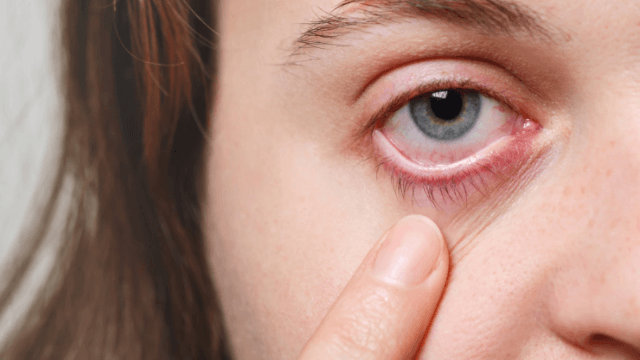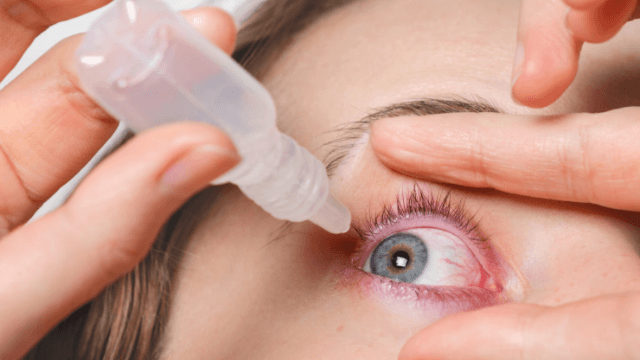The appearance of "red blood" in the eyes is something that everyone may encounter. Most people's first reaction is to overuse their eyes or not to rest enough. However, it is not easy behind red eyes. It may be that these eye diseases are "causing trouble"!
Xerophthalmia
Dry eye is a chronic ocular surface disease caused by multiple factors. It is an unstable tear film or an imbalance of the ocular surface microenvironment caused by abnormal tear quality, quantity and dynamics. It may be accompanied by ocular surface inflammation, tissue damage and neurological abnormalities. , causing various symptoms of eye discomfort and (or) visual dysfunction. Simply put, it is dry eyes. One of the typical symptoms of dry eye is redness, thickening of the conjunctival blood vessels, and redness in color. To prevent dry eye syndrome, we should try our best to intervene in various aspects, such as minimizing the time spent looking at mobile phones and computers, using proper eye distance control, blinking more, using humidifiers in air-conditioned rooms, adjusting sleep, improving sleep quality, and reducing staying up late, etc.

Glaucoma
Glaucoma is a kind of disease characterized by optic atrophy and visual field defect caused by pathological high intraocular pressure. Although not all people with glaucoma experience redness, it is common in acute angle-closure glaucoma with a sudden increase in intraocular pressure.

What are the symptoms of acute angle-closure glaucoma?
1. Pain: distending pain in the eyeball, distending pain in the root of the nose and orbit, and headache. The headache is mostly located on the forehead and temple. It can be a severe migraine or a dull pain from light to heavy. Severe pain can be accompanied by nausea and vomiting.
2. Red: The eyeball is bloodshot, dark red in color and unclear in outline.
3. Blur: blurred vision, sometimes looking at lights, especially incandescent lamps, you can see a rainbow of seven colors.
4. Close: Photophobia, dare not open eyes in the sun, always blink or even close eyes, keep crying.
If the above situation occurs, that is, a sharp increase in intraocular pressure, you should seek medical attention in time to avoid irreversible damage to the eyes caused by long-term high intraocular pressure.
Subconjunctival hemorrhage
The so-called subconjunctival hemorrhage, that is, the rupture of the capillaries under the conjunctiva causes hemorrhage, and the oozing blood is confined between the conjunctiva and the eyeball, causing acute red eye. Usually there is a red spot on the white eyeball. In this case, there is no need to worry, and the congestion will be absorbed by itself in 7-12 days. People often confuse "conjunctival congestion" with "subconjunctival hemorrhage". People usually have red blood in the eyeball after staying up late or when the eyes are too tired. This is just the dilation and congestion of blood vessels, which is medically called "conjunctival congestion".

Subconjunctival hemorrhage is generally stimulated by external forces, such as rubbing the eyes vigorously, coughing violently, vomiting, and straining to defecate. When people cough and constipation, due to excessive force, the abdominal pressure increases, which vibrates the blood vessels, thereby causing the blood vessels to rupture. If the patient has been fatigued recently, it is likely that the hormones in the body have changed, which will make the capillaries weaker and more likely to cause subconjunctival hemorrhage. In addition, conjunctival inflammation, arteriosclerosis patients, high blood pressure, blood disease, kidney disease, certain infectious diseases (such as sepsis, typhoid fever), etc., can also cause subconjunctival hemorrhage.
Acute conjunctivitis
The most common symptoms of acute conjunctivitis are swelling, tearing, and increased secretions. Many people will say: "I didn't do anything, why am I suffering from acute conjunctivitis?" In fact, it "finds" you inadvertently. Acute conjunctivitis, also known as "pink eye", is the most common infectious eye disease in ophthalmology clinics. Because the incubation period of pink eye disease is about 24 hours, some longer will last 3-5 days, and the incubation period will not have too many manifestations, so many patients do not realize that they are sick after they become ill.

Reminder: Once you find red eyes, accompanied by pain and increased secretions, you should go to the hospital for inspection in time to avoid the aggravation of the disease and the spread of the disease due to pink eye.
Chronic conjunctivitis
The symptoms of chronic conjunctivitis are not exactly the same as those of acute conjunctivitis, and the manifestations are also diverse. The more significant symptoms are the redness and bloodshots in the white part of the eyes, and the patient will feel dry, astringent, and itchy eyes. As a common eye disease in modern life, the incidence of chronic conjunctivitis has been increasing in recent years. Because the early symptoms of chronic conjunctivitis are not serious, it does not affect life very much. Therefore, many patients often do not pay enough attention, and it is easy to miss the best treatment period.
If not treated in time, the condition will continue to aggravate. In severe cases, it may lead to diseases such as dry eye syndrome, acute and chronic dacryocystitis, and ultimately seriously affect the daily life of patients.
Popular Articles
-
Allows you to hang more clothes in your closet

-
 fried pork livers
fried pork liversApr 27, 2025
-
 Excellent kitchen supplies recommended to give you a sense of well-being when cooking
Excellent kitchen supplies recommended to give you a sense of well-being when cookingApr 27, 2025
-
 Let people love a few home goodies, although cheap, but can save a lot of housework
Let people love a few home goodies, although cheap, but can save a lot of houseworkApr 27, 2025
-
 Take you to understand polycystic ovary syndrome
Take you to understand polycystic ovary syndromeApr 27, 2025
-
 Friends recommended to me these home goodies, seemingly "inconspicuous", but changed the life experience
Friends recommended to me these home goodies, seemingly "inconspicuous", but changed the life experienceApr 27, 2025







Comments
0